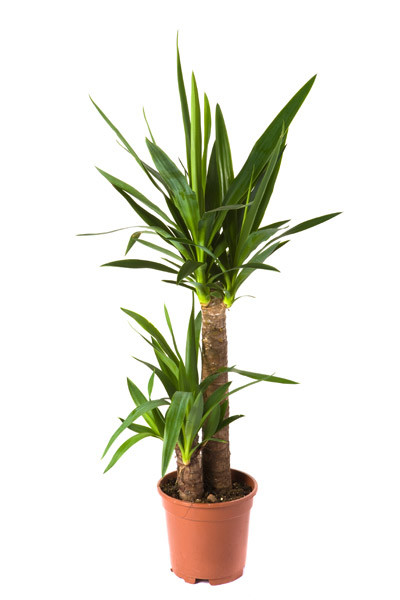 Yucca care at homeAgave family.Homeland: North America. An evergreen beautiful plant with linear prickly-pointed leaves. The leaves are collected in an ornamental rosette at the end of the trunk. In appearance, it is very similar to dracaena with green leaves (but is not related to it) and is also hardy and does not present any problems in culture. Common species:
Yucca care at homeAgave family.Homeland: North America. An evergreen beautiful plant with linear prickly-pointed leaves. The leaves are collected in an ornamental rosette at the end of the trunk. In appearance, it is very similar to dracaena with green leaves (but is not related to it) and is also hardy and does not present any problems in culture. Common species:
- Yucca aloifolia has a dense rosette of sword-shaped leaves, up to 55 cm long. The leaves have very sharp tips. It has a distinct trunk.
- Yucca elephantipes —similar to the previous species, but the tips of its leaves are not sharp. The most common species available for sale. It is usually sold as a rooted thick tree-like cutting with several rosettes of leaves. It grows slowly, reaching a height of about 1.5 meters.
Growing a large plant takes time,since yucca is a slow-growing plant. From mid-May to the end of September it can be taken out onto a balcony, terrace or into the garden, into an open sunny place (prepare for sunlight in advance by first placing it in light shade). Yuccas are good because they are not susceptible to dry indoor air, and this, as many people know, is important.
Care Tips
 Temperature:Moderate, cool in winter, preferably 16-18 C, but not below 8 C. In winter, when keeping yucca in normal room conditions, the room should be ventilated, but cold drafts should be avoided. Lighting: Light, sunny place. In summer, yucca prefers to be placed in the fresh air on a balcony, in the garden, etc. In winter, you will have to move the yucca as close to the window as possible, since in winter these plants especially suffer from a lack of light; in this case, the fan of leaves will not be lush and dense. Watering: Abundant from spring to autumn, but there should be no water left on the tray; in winter, water moderately. If kept in cool conditions in winter, water rarely, but do not allow the earthen lump to dry out. Yucca does not tolerate stagnant water in the soil. This can lead to root rot and stem rot. Air humidity: Does not require spraying the leaves, but sometimes it is necessary to arrange a wash so that the plant does not become dusty and does not lose its attractiveness. In summer, rain washes are sufficient outdoors. If in winter the yucca is kept in a room with central heating, then it is advisable to spray at least once a day. Transplanting: The soil should be nutritious. For young plants, 2 parts turf soil, 2 parts leaf soil, 1 part humus and 2 parts sand. For adult and old plants 3 parts turf soil, 2 parts leaf soil, 2 parts sand. Yucca is replanted every two years in the spring. Yucca is planted in a large pot or tub. Good drainage is essential. From April to August, every two weeks, fertilize with fertilizers, which significantly accelerate growth. Reproduction: In spring, by rooting the top of the stem, as well as pieces of the trunk (at least 10 cm long). Reproduction is possible by seeds and shoots. When propagating yucca by shoots, a daughter rosette is cut off from the main trunk with a sharp knife, and the cut on the trunk is sprinkled with sulfur. The cut off rosette is rooted in damp sand, and after rooting, it is planted in a pot with soil, to which pieces of wood (for example, birch) charcoal are added. It is advisable to cut off daughter rosettes for propagation in spring or summer, since at other times of the year they will not take root or will take a very long time to take root, in addition, this can harm the mother plant. When propagating yucca by seeds, it is important that they are fresh. The seeds are soaked for a day in warm water, then sown in a mixture of light leaf soil and peat. The bowl is covered with glass or a bag and aired several times a day. Usually the seeds germinate within a month.
Temperature:Moderate, cool in winter, preferably 16-18 C, but not below 8 C. In winter, when keeping yucca in normal room conditions, the room should be ventilated, but cold drafts should be avoided. Lighting: Light, sunny place. In summer, yucca prefers to be placed in the fresh air on a balcony, in the garden, etc. In winter, you will have to move the yucca as close to the window as possible, since in winter these plants especially suffer from a lack of light; in this case, the fan of leaves will not be lush and dense. Watering: Abundant from spring to autumn, but there should be no water left on the tray; in winter, water moderately. If kept in cool conditions in winter, water rarely, but do not allow the earthen lump to dry out. Yucca does not tolerate stagnant water in the soil. This can lead to root rot and stem rot. Air humidity: Does not require spraying the leaves, but sometimes it is necessary to arrange a wash so that the plant does not become dusty and does not lose its attractiveness. In summer, rain washes are sufficient outdoors. If in winter the yucca is kept in a room with central heating, then it is advisable to spray at least once a day. Transplanting: The soil should be nutritious. For young plants, 2 parts turf soil, 2 parts leaf soil, 1 part humus and 2 parts sand. For adult and old plants 3 parts turf soil, 2 parts leaf soil, 2 parts sand. Yucca is replanted every two years in the spring. Yucca is planted in a large pot or tub. Good drainage is essential. From April to August, every two weeks, fertilize with fertilizers, which significantly accelerate growth. Reproduction: In spring, by rooting the top of the stem, as well as pieces of the trunk (at least 10 cm long). Reproduction is possible by seeds and shoots. When propagating yucca by shoots, a daughter rosette is cut off from the main trunk with a sharp knife, and the cut on the trunk is sprinkled with sulfur. The cut off rosette is rooted in damp sand, and after rooting, it is planted in a pot with soil, to which pieces of wood (for example, birch) charcoal are added. It is advisable to cut off daughter rosettes for propagation in spring or summer, since at other times of the year they will not take root or will take a very long time to take root, in addition, this can harm the mother plant. When propagating yucca by seeds, it is important that they are fresh. The seeds are soaked for a day in warm water, then sown in a mixture of light leaf soil and peat. The bowl is covered with glass or a bag and aired several times a day. Usually the seeds germinate within a month.









